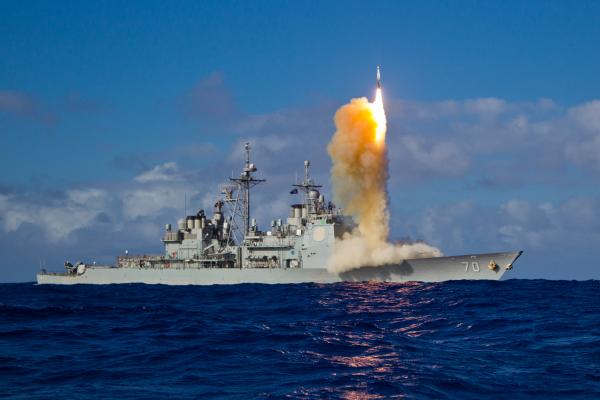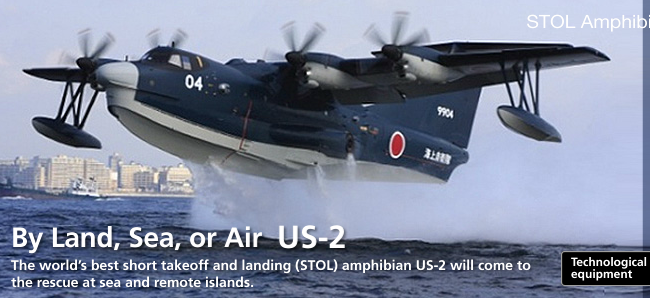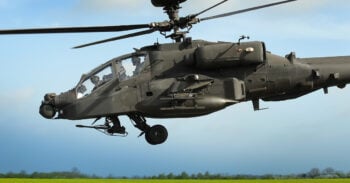
Navy cruiser Lake Erie launches a SM-3 IB missile. Japan is co-producing the latest version.
Japan and the US just threw open the door to arms sales between the two longtime allies, something Japan had long resisted. The deal is the latest sign of how fear of a rising China is pushing Japan away from its post-World War II pacifism. Defense Secretary Ashton Carter and his Japanese counterpart Gen Nakatani quietly signed the Reciprocal Defense Procurement (RDP) pact Friday on the sidelines of the Shangri-la Dialogue, where Carter called for an “inclusive (and) principled security network” linking longstanding treaty allies like Japan with newer partners such as Singapore.
With this agreement, Japan becomes the first Asian nation to join 23 existing RDP signatories — including Israel, Egypt, Sweden, and many NATO members — whose defense products are exempted from Buy America laws and other protectionist provisions. Joining that club is a major achievement for Prime Minister Shinzo Abe, who has (controversially) sought to make Japan a more “normal” nation, able to cooperate with foreign partners in both military operations and production. The RDP is also a major achievement for a country that outright banned its industries from selling arms abroad until two years ago.
“DOD has been trying to negotiate a reciprocal agreement with the Japanese for decades, but the big hurdle has been the ‘reciprocal’ part of this: the Japanese being willing to export technology … and the willingness to open up their defense market,” said a Hill staffer. “The implications for two way defense cooperation – particularly in missile defense technology – could be pretty significant.”
“If you look at trade data, for aerospace civil imports, they’re one of our largest suppliers; if you look on the defense side, it’s zero,” said Joel Johnson, an analyst at the Teal Group. The Reciprocal Defense Procurement pact could blow that open. An RDP boils down to an agreement that “we will treat your companies as if they’re US nationals and you will treat our companies as if they’re Japanese nationals,” Johnson said. “Buy America provisions are waived on everything but textiles and footwear.”

ShinMaywa US-2 amphibious airplane.
That said, don’t expect the US to start buying, say, Soryu-class submarines from Mitsubishi, P-1 patrol aircraft from Kawasaki, or US-2 seaplanes from ShinMaywa. Even setting protectionist politics aside, US requirements tend to be too unique (and too expensive) for other countries’ war machines to meet. India is a much more likely customer for the seaplane, for example, while the submarines lost out to French rivals for a major Australian purchase.
Conversely, Japan already produces variants of some US systems under license or joint production agreements: Fuji’s UH-1J Huey helicopter, for example, or the F-16 derivative F-2 fighter. Overall, said Bryan Clark, a former aide to the Chief of Naval Operations now with the Center for Strategic & Budgetary Assessments, “Japan imports US technology in key areas such as undersea warfare, electronic warfare, stealth, and strike weapons, rather than the other way around.”
Instead, the practical impact of the agreement — at least in the near term — is that it eases the sale of high-tech Japanese components for US weapons systems.
“We don’t normally buy whole platforms from other countries, but some foreign components and mission systems such as weapons, sensors, jammer pods, etc. are more effective than current US capabilities,” said Clark. “In the past, RDPs have mostly increased the purchases of component parts from foreign suppliers for larger systems that are built by US companies.”
So what might the Japanese have to offer? “They’ve always been great on optics [such as] cameras,” Johnson told me. “They’ve got night vision” and are generally strong in electronics. (Although, he noted, “they have the same problem we do, a bunch of their foundries are in China,” raising issues of counterfeit, bugged, or outright sabotaged components).
Japan already builds parts for the Patriot missile and is co-developing the latest upgrade of the Standard Missile SM-3. Both are missile defense systems whose capabilities make them attractive to a Japan menaced by North Korean rockets.
Selling parts for more offensive systems, however, might run afoul of still-strong pacifist sentiment in Japan, especially if US systems with Japanese components are exported to third parties. “They’re particularly allergic to anything where combat is going on,” Johnson said. “We could get tangled up with them over Israel,” which many European countries are already reluctant to sell military equipment.
“The Japanese will have some rough patches ahead as they try to sort out how to do all this,” Johnson said. “It’s probably going to be a bigger strain on them than on us because we’re used to doing reciprocal procurement,” whereas Japan has just opened the door to exporting arms.”
“It certainly opens the door to the Japanese selling to the US military,” he said, “but the Japanese are still going to have to decide what kind of hardware they want to sell, and under what conditions — and are those going to be acceptable to buyers?”
TAI exec claims 20 Turkish KAAN fighters to be delivered in 2028
Temel Kotil, TAI’s general manager, claimed that the domestically-produced Turkish jet will outperform the F-35 Joint Strike Fighter.


























